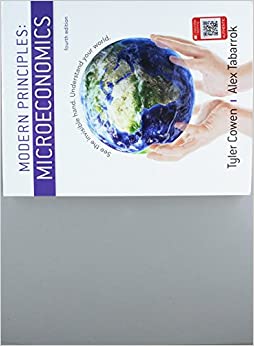Question
Think The government intervenes in markets in a variety of ways. Taxes, subsidies, and price controls directly impact the price and quantity of the good
Think
The government intervenes in markets in a variety of ways. Taxes, subsidies, and price controls directly impact the price and quantity of the good bought and sold in a market and can create economic inefficiencies. Additionally, there are times when government interventions may enhance economic efficiency in the market. Usually, in the situation where of externality or a situation where the good is a public good or common resource, government intervention can be efficiency enhancing. Use the following events from Spring of 2020 to discuss the role of government policy in the rationing of goods.
Background and Instructions:
If you are unfamiliar with the news story, read the background to the question. Then answer the questions in the space provided. Be sure to be clear and concise and to use economic concepts from this week's readings and videos.
Question 1:
In Spring 2020, Wisconsin Governor, Tony Evers, closed 40 state parks in Wisconsin. Read the statement from the WI DNR for more information - https://dnr.wi.gov/news/releases/article/?id=5083 or https://www.jsonline.com/story/news/local/milwaukee/2020/04/09/evers-closes-40-state-parks-including-devils-lake-and-kettle-moraine-state-forest/5121220002/ . After waiving admission fees and encouraging park usage, Mr. Evers cited littering, unusually large crowds, and vandalism as reason for the closure. After you familiarize yourself with the story, answer the following question:
- What type of good is a public park that is overused that require no entry fees? Be sure to use the concepts of rivalry in consumption and excludability to define the good.
- What type of problem exists with type of good? Do they align with the issues cited by Governor Evers? How?
- Explain a policy or solution other than closing parks that would reduce the issues cited by the DNR and the governor.
Question 2:
On March 12, 2020, Governor Tony Evers declared a public health emergency due to the spread of COVID-19. A public emergency puts several laws into action that usually do not apply in regular times. One example of a law that goes into effect during an public emergency is price gouging laws. Read this brief article about price gouging https://fox6now.com/2020/03/15/for-1st-time-in-state-history-law-against-price-gouging-is-triggered-by-public-health-emergency/. In the article there is a picture of empty grocery shelves. Many people are unable to find toilet paper, hand sanitizer, bleach, paper towels, sanitizing wipes, etc. available in the store. Stores are prohibited to raise the price of these items by more than 15% in WI during a state of emergency. Answer the following questions about this economic situation for hand sanitizer.
- When a large enough increase in demand for a hand sanitizer product occurs, price gouging laws become a binding price _______________ (choose 1: floor or ceiling). In a market, this will cause a ______________ (choose 1: Shortage or Surplus).
- Illustrate the situation you described above with a supply and demand diagram. Be sure to fully label your graph (price on Y axis and quantity on X axis). Show the equilibrium price and quantity with P* and Q*. Show the difference between quantity supplied and quantity demanded due to the law. Clearly show the price gouging law on the graph. (you can draw your graph by hand or with a computer program but be sure that it is clear and legible).
- Price gouging laws distort the signal that prices in a market send. What are other methods of rationing that occur due to the law?
Step by Step Solution
There are 3 Steps involved in it
Step: 1

Get Instant Access to Expert-Tailored Solutions
See step-by-step solutions with expert insights and AI powered tools for academic success
Step: 2

Step: 3

Ace Your Homework with AI
Get the answers you need in no time with our AI-driven, step-by-step assistance
Get Started


